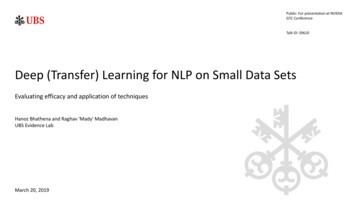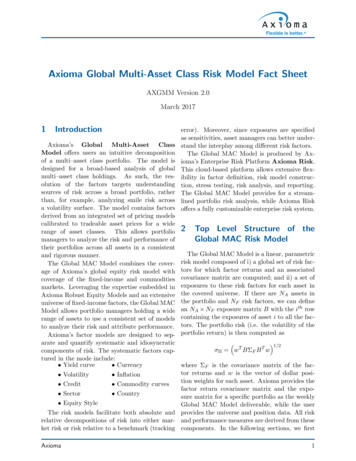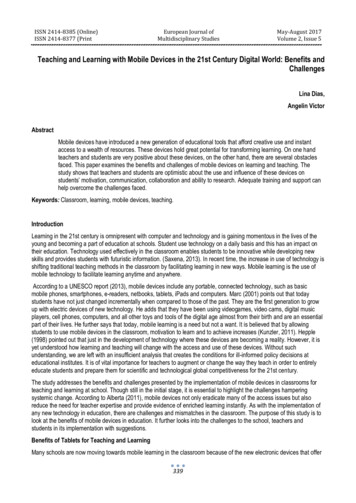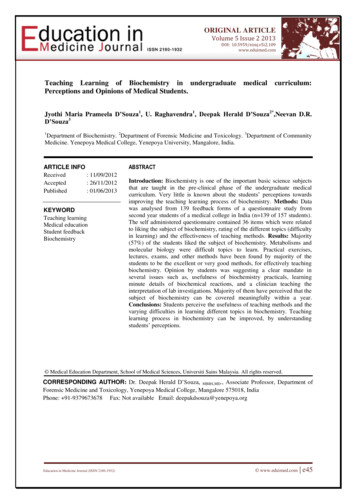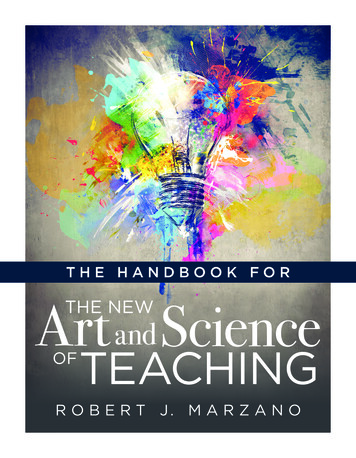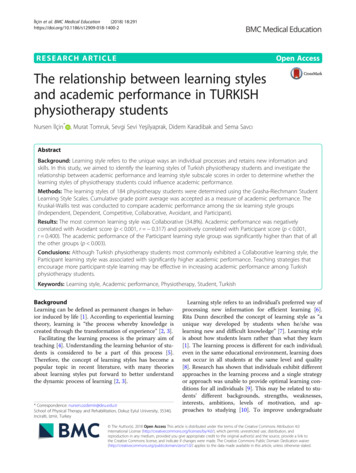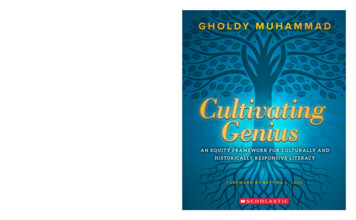
Transcription
Dr. Gholnecsar “Gholdy” Muhammadearned her Ph.D. in literacy, language, and culture at theUniversity of Illinois at Chicago (UIC). Her research has focusedon the social and historical foundations of literacy in Blackcommunities and how literacy development can be reconceptualizedin classrooms today. Dr. Muhammad is the recipient of multiple research awardsfrom the National Council of Teachers of English and from Georgia StateUniversity and UIC. She’s an associate professor at Georgia State University,where she also serves as the director of the Urban Literacy Collaborative andClinic. She works with teachers and youth across the U.S. and South Africa.Cultivating Genius CVR-full.indd 1-3IONUTIBSTRDIA N E Q U I T Y F R A M E WO R K F O R C U LT U R A L LY A N DH I S T O R I C A L LY R E S P O N S I V E L I T E R AC YT— Cornelius Minor, Brooklyn-basedEducator, Consultant, and AuthorCultivatingGeniusFOR—Alfred W. Tatum, Dean and Professor,University of Illinois at Chicago, College ofEducation. Author of Reading for Their Life.“This is the most important bookthat I have read in the last halfdecade. There were several timesthat I had to put it down to emote,to think, to mourn, to dream.Those of us who love and teachBlack children are constantlyhaving to disrupt, subvert,undermine, and destroy classroompractices and school policies thatmurder souls and steal futures. Inthis, we are robbed of countlessopportunities to co-constructpowerful, literate realities forchildren and their communities.Gholdy Muhammad reminds usthat we are architects, too—not justfighters. And Cultivating Geniusis one of our most powerfulblueprints for building on theliteracy legacy of our AfricanAmerican forebears.”G H O LDY M U H A M M A D 35.99 U.S.NO—Pedro A. Noguera, DistinguishedProfessor of Education, Faculty Director,Center for the Transformation of Schools,UCLA Graduate School of Education &Information Studies“In every generation a new voiceemerges that serves as areminder of our deeper human ityand its connection to theprinted word. Dr. GholdyMuhammad is that voice as shereminds us of the genius runningthrough the veins of children.Cultivating Genius, if read andunderstood in the spirit in whichit is written, will increase theprobability that children realizeand exercise their latent powerwithin. The field of literacy has anew gift, wrapped in its own bowof genius.”G H O LDY M U H A M M A D“In this powerful new book,Gholdy Muhammad reminds usthat literacy can be a source ofpower for young people and akey to transforming their lives.In this accessible and thoughtprovoking book, educators willfind Muhammad’s frameworkand the examples she usesilluminating and useful. Forthose who seek to use literacy asa force for equity, this book willbe an invaluable tool and guide.”Cultivating GeniusIn this book, award-winning researcher Dr. Gholdy Muhammad presentsa teaching and learning model that brings the history of illustriousAfrican American literary societies to bear on the way we teach today.The four-layered framework—identity, skills development, intellect, andcriticality— is essential for all young students, especially students of color,who tradition ally have been margin alized by learning standards, government policies, and school practices. Dr. Muhammad offers a blend ofpedagogical approaches that revolutionize teaching and learning acrossgrade levels and content areas. You’ll learn how to design historicallyresponsive learning goals and lesson plans that put this groundbreakingresearch into practice.FOREWORD BY BETTINA L . LOVE10/21/19 5:59 PM
IONUTSTR—Yolanda Sealey-Ruiz, Associate Professor of English Education,Teachers College, Columbia University“Cultivating Genius is about (re)membering thatequity and excellence have always been thehallmark of literacy traditions of Black andBrown peoples. It is about (re)storying themodels for literacy teaching and learning inways that (re)mind us all that identity, skills,criticality, and intellect have always been thefoundation of African American literacyteaching. Muhammad brilliantly writes animportant (re)member ing of who we are andour ways of being literate, one that puts cultureand community at the very heart of learningand teaching. That is where equity and excellence reside. Cultivating Genius (re)membersthat truth. And if equity and justice are to beattainable goals, we must (re)member it, too.”IB“Cultivating Genius is a timely, important, andeducator-friendly book that is needed nowmore than ever before. One cannot fullyengage the power of what is available throughculturally responsive lesson planning without applying Dr. Muhammad’s brilliant andinnova tive framework. This practical guideilluminates and translates theory in ways thatwill help educators bring about the changeneeded in literacy classrooms—change thatculturally responsive and sustaining pedagogies promise. In a sentence: This is the bookwe in the teacher education literacy fieldhave been waiting for.”— Cynthia B. Dillard, Ph.D. (Nana Mansa II of Mpeasem,Ghana, West Africa), Mary Frances Early Professor of TeacherEducation, University of GeorgiaAccess Your Companion dy Muhammad has written a trulybrilliant, necessarily bold, and absolutelybeautiful book! From her focus on utiliz inga Historically Responsive Literacy frameworkto her recognition of historical and contemporary embodiments of Black Excellence, BlackJoy, and Black Love, Cultivating Genius advocates for educational equity, transformation,and engaged teaching that cultivates thegenius of our students. What a read!”—Valerie Kinloch, Renée and Richard Goldman Dean of theUniversity of Pittsburgh School, University of Pittsburgh, School ofEducationNOT“Dr. Gholdy Muhammad has her ear attunedto the pulsing needs of youth of color andtheir teachers. She masterfully brings theoryto vibrant life in classrooms, providing educators with a framework that turns to historyto guide precisely the rich, responsive, andmultifaceted literacy learning we urgentlyneed in the present. In short, Dr. Muhammad’sconcept of Historically Responsive Literaciesis a game changer in literacy education.”“Cultivating Genius is a rare glimpse into thefuture. It is at once a framework for advanc ing equity in literacy education and a neededtreatment for undoing the historical ills ofracial injustice. It is smart and wonder fullyclear. This book offers the perfect blueprint forreimagining the possibilities of the classroom.”—David E. Kirkland, Professor, Urban Education at New YorkUniversity, Executive Director, New York University, Metro Center—Elizabeth Dutro, Professor, Literacy Studies Chair, LiteracyStudies Program School of Education, University of Colorado BoulderCultivating Genius CVR-full.indd 4-610/21/19 5:59 PM
UTIONG H O LDY M U H A M M A DDISTRIBCultivatingGeniusA N E Q U I T Y F R A M E W O R K F O R C U L T U R A L LYNOTFORA N D H I S T O R I C A L LY R E S P O N S I V E L I T E R A C YSP CULTIVATING GENIUS 001-015.indd 110/17/19 1:41 PM
And to my Baba.UTI dedicate this book to my mothers:Maria, Ajile, Evelyn, and Bernice.IONTo Al Mujib (The Responsive).STRIBPhotos : cover and throughout: johnwoodcock/Getty Images; 24: Monkey Business Images/Shutterstock; 31: Accessible Archives Inc. ;41: SDI Productions/iStockphoto; 46 top: Bongani Mnguni/City Press/Gallo Images/Getty Images; 46 bottom: AP Photo/Bill Hudson; 47:Courtesy of Oregon Historical Society; 48: kali9/iStockphoto; 53: Wilson Group Network, Inc.; 55: kali9/iStockphoto; 62: SDI Productions/iStockphoto; 66: Iakov Filimonov/Shutterstock; 71: Paul Popper/Popperfoto/Getty Images; 73: xavierarnau/iStockphoto; 83: Bettmann/Getty Images; 89: Monkey Business Images/Shutterstock; 106: wavebreakmedia/Shutterstock; 130: General Research Division, The NewYork Public Library; 131: Zurijeta/Shutterstock; 136: SpeedKingz/Shutterstock; 140: University of Detroit Mercy, Special Collections, BlackAbolitionist Archive; 151: Library of Congress. All other photos by Josh Moïse for Scholastic Inc.Excerpt from “Hidden Name and Complex Fate” from Shadow and Act by Ralph Ellison. Copyright 1953, 1964 by Ralph Ellison.Reprinted by permission of Random House, Inc., a division of Penguin Random House LLC. All rights reserved.Excerpt from To Be a Slave by Julius Lester. Copyright 1968 by Julius Lester. Reprinted by permission of Penguin Young Readers Group,a division of Penguin Random House LLC. All rights reserved.Excerpt from Long Walk to Freedom: The Autobiography of Nelson Mandela by Nelson Mandela. Copyright 1994, 1995 by NelsonRolihlahla Mandela. Reprinted by permission of Little, Brown and Company, a division of Hachette Book Group, Inc. All rights reserved.DIExcerpt from the speech “What Is Your Life’s Blueprint?” delivered by Dr. Martin Luther King Jr. to students at Barratt Junior High inPhiladelphia on October 26, 1967. Copyright 1967 by Dr. Martin Luther King Jr., renewed 1991 by Coretta Scott King. Reprinted byarrangement with The Heirs to the Estate of Martin Luther King Jr., c/o Writers House as agent for the proprietor New York, NY.All rights reserved.FORPublisher: Lois BridgesEditorial director: Sarah LonghiEditor-in-Chief: Raymond CoutuDevelopment/production editor: Danny MillerSenior editor: Shelley GriffinAssistant editor: Molly BradleyEditorial assistant: Sean CavanaghCover designer: Tom MartinezInterior designer: Maria LiljaScholastic is not responsible for the content of third-party websites and does not endorse any site or imply that the information on thesite is error-free, correct, accurate, or reliable.TNo part of this publication may be reproduced in whole or in part, or stored in a retrieval system,or transmitted in any form or by any means, electronic, mechanical, photocopying, recording,or otherwise, without written permission of the publisher. For information regarding permission,write to Scholastic Inc., 557 Broadway, New York, NY 10012.NOCopyright 2020 by Gholdy Muhammad.All rights reserved. Published by Scholastic Inc.Printed in the U.S.A.ISBN-13: 978-1-338-59489-8SCHOLASTIC and associated logos are trademarks and/or registered trademarks of Scholastic Inc.Other company names, brand names, and product names are the property and/or trademarks of their respective owners.Scholastic does not endorse any product or business entity mentioned herein.1 2 3 4 5 6 7 8 9 104028 27 26 25 24 23 22 21 20 19Text pages printed on 10% PCW recycled paper.Scholastic Inc., 557 Broadway, New York, NY 10012SP CULTIVATING GENIUS 001-015.indd 210/17/19 1:41 PM
IONContentsACKNOWLEDGMENTS. . . . . . . . . . . . . . . . . . . . . . . . . . . . . . . . . . . . . . . . . . . . . . . . . . . . . . . . . . . . . . . . . . . . . . . . . . . . 5UTFOREWORD BY BETTINA L. LOVE. . . . . . . . . . . . . . . . . . . . . . . . . . . . . . . . . . . . . . . . . . . . . . . . . . . . . . . . . 6INTRODUCTION: Restoring Equity and Excellenceto Today’s Classrooms. . . . . . . . . . . . . . . . . . . . . . . . . . . . . . . . . . . . . . . . . . . . . . . . . . . . . . . . . . . . . . . . . . . . . . . . . . . . . 8IBPART ONE: Drawing From History to ReimagineLiteracy Education. . . . . . . . . . . . . . . . . . . . . . . . . . . . . . . . . . . . . . . . . . . . . . . . . . . . . . . . . . . . . . . . . . . . . . . . . 16STRCHAPTER 1: How 19th-Century Black LiterarySocieties Can Elevate Today’s Literacy Learning. . . . . . . . . . . . . . . . . . . . . . . . . . . 18CHAPTER 2: What Is Historically Responsive Literacy?. . . . . . . . . . . . . . . . 38PART TWO: Teaching and LearningWith the Four-Layered HRL Framework. . . . . . . . . . . . . . . . . . . . . . . . . . . . . . . . . . 62DICHAPTER 3: Toward the Pursuit of Identity. . . . . . . . . . . . . . . . . . . . . . . . . . . . . . . . . . 64CHAPTER 4: Toward the Pursuit of Skills. . . . . . . . . . . . . . . . . . . . . . . . . . . . . . . . . . . . . . 82FORCHAPTER 5: Toward the Pursuit of Intellect. . . . . . . . . . . . . . . . . . . . . . . . . . . . . . . 100CHAPTER 6: Toward the Pursuit of Criticality. . . . . . . . . . . . . . . . . . . . . . . . . . . . . 116PART THREE: Implementing Historically ResponsiveTexts and Lesson Plans. . . . . . . . . . . . . . . . . . . . . . . . . . . . . . . . . . . . . . . . . . . . . . . . . . . . . . . . . . . . . . . . 134CHAPTER 7: Selecting Historically Responsive Texts. . . . . . . . . . . . . . . . . 136NOTCHAPTER 8: Using Historically Responsive Lesson Plans. . . . . . . . . . 156AFTERWORD BY MAISHA T. WINN. . . . . . . . . . . . . . . . . . . . . . . . . . . . . . . . . . . . . . . . . . . . . . . . . . . . 170REFERENCES. . . . . . . . . . . . . . . . . . . . . . . . . . . . . . . . . . . . . . . . . . . . . . . . . . . . . . . . . . . . . . . . . . . . . . . . . . . . . . . . . . . . . . 172INDEX. . . . . . . . . . . . . . . . . . . . . . . . . . . . . . . . . . . . . . . . . . . . . . . . . . . . . . . . . . . . . . . . . . . . . . . . . . . . . . . . . . . . . . . . . . . . . . . . . . 174SP CULTIVATING GENIUS 001-015.indd 310/17/19 1:41 PM
CHAPTER 2UTIONWhat Is HistoricallyResponsive Literacy?FORDISTRIBIt has been most happily said, by one of the greatest ofmodern philosophers, that “Knowledge is power;” andnever has the excellency of its possession been doubted bythe candid and liberal; but education must begin in youth,in order to furnish men of erudition. Our youth are the menof a coming age; and who can calculate the importance ofcompetent instruction in the development of their powers,and in the formation of their minds. How many millionsare ruined in their early days, for the want of goodinstruction! Yes! We need to be constantly remindedof the power of education, right or wrong, thorough orsuperficial, controlled or slighted—to make or ruin thehopes of our country; and in reference to this subject,it has been said, with propriety, that a man cannot leavehis country a better legacy than a well-educated family.—Robert SearsTNOThis stirring quote by Robert Sears, a White contributor who oftencritiqued the current state of politics and education in the UnitedStates, was originally published July 8, 1837, in The Colored Americannewspaper. Sears argued that a quality education and quality of life areintertwined human rights and must be both excellent and powerful. Fordecades, communities of color especially have been resisting wrongful,deficit-based education. Indeed, we have worked to name and describethe education we deserve to avoid the ruin of poor education.38SP CULTIVATING GENIUS 016-061.indd 38Cultivating Genius: An Equity Framework for Culturally and Historically Responsive Literacy10/15/19 6:43 PM
Cultural Theories and ModelsSTRIBUTIONFrom her work with successful teachers of African American students,Gloria Ladson-Billings coined the term culturally relevant education.Following the ancestors’ examples, Ladson-Billings named and describedthe type of education African American students deserved. She definedculturally relevant education as a “theoretical model that not onlyaddresses student achievement, but also helps students to acceptand affirm their cultural identity while developing critical perspectivesthat challenge inequities that schools (and other institutions) perpetuate”(1995, p. 469). At this time, culturally relevant education was seen asa theory for reframing education to not only structure learning to bemore identity-centered, but also to focus on sociopolitical learningin student achievement.Marginalization and Other ChallengesDIThe need for culturally relevant education stemmed from the multipleways Black children and other youth with “kindred struggles” (Johnston,D’Andrea Montalbano & Kirkland, 2017) were marginalized and treatedpoorly in schools. In fact, when I examined research related to the literacydevelopment of Black girls and boys over the past 25 years, I (along withco-researchers) found the following:The nation’s educators still struggle with how to advancethe literacy development of Black boys and girls. The reading performance of middle and high school–agedBlack children has remained relatively flat since the 1980s dueto instruction and other factors. Black girls are often negatively represented in and out of schools,and the focus has been on their behavior, not their academicaptitude.TFOR Black girls are among the highest-growing populationsof incarcerated youth.NO There are several influences shaping their academic trajectories inthe categories of instructional (skills and strategies), sociocultural(home environment and access to economic, human, andChapter 2: What Is Historically Responsive Literacy?SP CULTIVATING GENIUS 016-061.indd 393910/15/19 6:43 PM
community resources), and personal (confidence, individualattributes) factors. Instruction is largely ahistorical—that is, the ways people of colorhave excelled in literacy historically are absent from the wayseducators engage them in instruction today (Tatum & Muhammad,2012; Muhammad & Haddix, 2016).IONCHAPTER 2 IBUTAdditionally, there is a growing mismatch of incoming teachers andstudents. Teachers are largely White, female, and monolingual, whileclassrooms are increasingly multilingual and multi-ethnic (Zumwalt &Craig, 2005). This does not mean that these teachers cannot teach Blackand Brown students excellently, but it means that work needs to be doneto learn and respond to the social and cultural lives of students.NOTFORDISTRThis work is often beyond what most teacher preparation programs offer.Such programs generally do not ground teacher preparation in Black orcultural studies. Nor do most teacher preparation programs centralizeanti-racism, anti-oppression, or learning about Black educationalhistory or Black learning theorists. In fact, we too often see “diversity”or “multicultural” classes as isolated efforts rather than grounding entireprograms in intersectionality as we see in Black and cultural studiesprograms. Urban education courses will have classes related to povertybefore having a class centered on Black and Brown excellence. Ironically,an urban education class on poverty doesn’t capture the current natureof urban cities across the U.S. as many people of color are being pushedout of urban areas due to gentrification. If we as a nation are strugglingto “get it right” with Black and Brown student populations, shouldn’t weground teacher preparation in the essence of Black and cultural learningtheories and practices? Instead, again and again, I find that curricularmandates in our nation’s largest school districts are often written andguided by Whiteness and lack education that teaches youth to be sociallyand politically conscious beings—which are intelligences that they needto survive and thrive during and after K–12 education (Love, 2019).40SP CULTIVATING GENIUS 016-061.indd 40Cultivating Genius: An Equity Framework for Culturally and Historically Responsive Literacy10/15/19 6:43 PM
IONDeficit LanguageFORDISTRIBUTAnother problem that led to the need for culturally relevant educationis the deficit language surrounding the lives of children of color—language such as at risk, defiant, and disadvantaged. More recent policiesand programs such asResponse to Interventioncontinue to perpetuateinadequate thinking aboutyoung people of color,giving them labels suchas “red group” or “tier 3.”These labels also connectto naming youth as “nonreaders,” or “strugglingreaders.” In a statementof culturally responsiveeducation, Johnston,D’Andrea Montalbano &Kirkland (2017) stated:“The creation andassignment of such labelsseparates students intothose who are alienatedfrom their identities and those alienated from education as unuseful,unproductive, or likely unsuccessful and they are further told similarmessages of inadequacy and undesirability in media and society” (p. 18).This speaks to the harmful consequences of such labels for youth andtheir lives. Students may struggle in reading print, but it should not bethe central ways in which they are defined.NOTMany times, youth may struggle with skills like decoding or reading fluency,but they can read social contexts and environments exceptionally well.They can read teachers’ moods and temperaments and if they feel theteachers like them or not. They become very skilled at reading people,expressions and dispositions. This type of reading shouldn’t goChapter 2: What Is Historically Responsive Literacy?SP CULTIVATING GENIUS 016-061.indd 414110/15/19 6:43 PM
IONCHAPTER 2unacknowledged, especially since this sociocultural reading of contexts andpeople have historically counted as reading among Black people. In truth,this contextual reading led many enslaved people to gaining freedoms.The problems leading to the need for culturally relevant education havebeen inadequately addressed by many policies and initiatives in education.These become fresh coats of paint on structures that are debilitating.NOTFORDISTRIBUTWhile the look of these new approaches may seem different andinnovative, they are not. They are just masking the same systemic waysof being and thinking about learning. These approaches continue tomarginalize those who are already underserved in and out of schools.Examples of this “repainting,” to name a few, are evident in No Child LeftBehind, Response to Intervention, and Race to the Top. More recentlythe College Board announced the “adversity score” for the SAT, whichdoesn’t get to the root of the problem with inequities and testing bias.These have been promoted under the guise of true equity, but they haveinstead either perpetuated harm on their own or, at best, failed to attackthe root of the problem. Further, critical theorists of color are not largelythe authors of these initiatives.42SP CULTIVATING GENIUS 016-061.indd 42Cultivating Genius: An Equity Framework for Culturally and Historically Responsive Literacy10/15/19 6:43 PM
Culturally Relevant EducationSTRIBUTIONLadson-Billings made quite a mark on educational research andpedagogical practice because she began to put a name to the practicesBlack people have engaged in from the moments they were forciblybrought to the United States until contemporary times. Culturally relevanteducation (although not yet named) can be found in African philosophiesof education, Black-centered schools in the United States, practices in Blackliterary societies, directions for education in Civil Rights and Black Powermovements, and scholarship from authors such as Anna Julia Cooper, MaryMcLeod Bethune, Carter G. Woodson, and W. E. B. Du Bois. This certainly isnot an exhaustive list but begins to signify that Black people throughouthistory have laid the groundwork for education for all. I also found in aDecember 1, 1969 article in the Black News newspaper a list of 15 demandsby Black high school students. These demands included:1. No more automatic suspension of high school students2. No more police or police aides inside NYC schoolsDI3. Strict adherence to fire regulations—doors to schools mustbe left open4. Open the schools daily to parent observationFOR5. Community rehabilitation centers must be allowed to set upprograms to treat known drug addicts in the school buildings6. Elimination of the General Course of Study7. Elimination of all Regents Exams8. Recognition in all NYC schools of two Black Holidays: May 19(Malcolm X’s birthday) and January 15 (Martin Luther King, Jr.’sbirthday)NOT9. Immediate alternation of teacher population and examinationsto supply Black educators proportionate to the student population10. Complete examination of all books and educational supplies andmaterials used by the schools to their adequacy and relevancyChapter 2: What Is Historically Responsive Literacy?SP CULTIVATING GENIUS 016-061.indd 434310/15/19 6:43 PM
IONCHAPTER 211. The creation of school clubs along ethnic lines with facilitiesand funds from the G.O.12. Improved conditions for the students in the schools, suchas music in the lunchrooms, more dances, improved athleticprograms, and self-defense classes13. Teachers with a background related to the course they are teachingUT14. Creation of Student Faculty Council (equal representation),in each school which will make decisions on the following matters:curriculum, school staff, discipline, rules and regulations, etc.STRIB15. The reorganization of the high schools along community linesso that Black students will not be forced to go to schools in hostilecommunities and seek an educationFORDIThreaded throughout these demands is the naming and demand forculturally relevant education spoken by youth. Using their minds and pensas a form of literary activism, they demand systems, structures, curriculum,and instruction that is connected to their lives and the sociopoliticalnature of the community. Number 10 especially called for a review andexamination of educational materials for the relevancy to theidentities of students. This is yet another historically documentedexample of Black people calling for culturally relevant education.Other demands teach educators that if we just listen to the voicesUsing their mindsof youth, we will know exactly what to do in solving the problemsand pens as a formin education. Their statements spoke to the need to have teaching,of literary activism,learning, and schooling be responsive to their histories, identities,they demand systems,literacies, and times in which they live.NOTstructures, curriculum,and instructionthat is connectedto their lives.44SP CULTIVATING GENIUS 016-061.indd 44Cultivating Genius: An Equity Framework for Culturally and Historically Responsive Literacy10/15/19 6:43 PM
IONConnecting Instruction to Students’ CulturalIdentities and PracticesIBUTCarrying the words of the youth and of Black history, Ladson-Billings’work informed educators of the importance of designing curriculum andinstructional practices that authentically connect to students’ culturalidentities and cultural practices. Teachers were encouraged to incorporatestudents’ cultures into their teaching as assets to classroom instructionrather than deficits to overcome (Paris, 2012). Culture is such a broad term,but has been defined as shared and common beliefs, models for living,and practices by a group of people. Cultural relevance is equity-centeredand charges educators to engage in practices that push for social justice.Ladson-Billings (2014) concluded three major domains of the successfulteachers’ work:STR1. Academic Success or the intellect students gain as resultof classroom instruction and learning2. Cultural Competence or the ability to help students appreciateand celebrate their cultures of origin while gaining knowledgeof and fluency in at least one other cultureDI3. Sociopolitical Consciousness or the ability to take learning beyondthe confines of the classroom using school knowledge and skillsto identify, analyze, and solve real-world problems (p. 75)NOTFORFollowing this, in her 2000 text entitled Culturally Responsive Teaching:Theory, Research, and Practice, Geneva Gay elaborates on the term “culturalresponsiveness.” She defines culturally responsive teaching as “using thecultural characteristics, experiences, and perspectives of ethnically diversestudents as conduits for teaching them more effectively” (Gay, 2002).Her premise rests on the philosophy that teachers can’t teach untilthey deeply know and understand cultural and ethnic ways of knowingand being, and this includes the tools, protocols, values, traditions,and ways of living of the students they teach. Gay (2010) suggests thatstudents’ interest and engagement in learning increase when educatorsuse pedagogies connected to their experiences. Additionally, teachersusing this approach see curriculum as a tool of power and a disruption ofmarginalization. In contrast, when students in classrooms do not receivesuch curriculum with elements of care, love, and respect at the center,Chapter 2: What Is Historically Responsive Literacy?SP CULTIVATING GENIUS 016-061.indd 454510/15/19 6:43 PM
IONCHAPTER 2they tend to display resistance to the curriculum and instruction, as well asto teachers and to the school (Johnston, D’Andrea Montalbano & Kirkland,2017). This resistance is usually called defiance and negative behavior inschools today. I want to remind readers of three moments in history whenyouth have resisted curriculum and instruction that lacked equity, access,and cultural relevance. They were consequently called defiant.Picture #2—In this photo,elementary-aged Blackchildren are being takento jail on May 4, 1963,after their arrest forprotesting segregationin the United States.NOTFORDISTRIBUTPicture #1—In the 1970sin South Africa, this photodisplays Black childrenresisting Bantu education,which had substandardcurriculum and resourcesin South Africa. They werealso forced to learn inthe Afrikaans language(which the youth calledthe oppressor’s language),which was a languagenot spoken in the homesand communities ofindigenous Africans.46SP CULTIVATING GENIUS 016-061.indd 46Cultivating Genius: An Equity Framework for Culturally and Historically Responsive Literacy10/15/19 6:43 PM
IONUTIBSTRPicture #3—In this photo from the 1960s, there is protest by young peopleresisting an education that didn’t give them proper books and instruction.FORDIWhat is common among all three historical photos is that when we lookat them today, we speak of the students’ bravery and courage to organizein ways to interrupt wrongdoing. Black students today don’t receive thatsame commentary, yet they are in similar ways resisting curriculum andinstruction that were not designed to advance their academic successor personal achievement.Culture-Centered Theories and ModelsTIn the midst of Ladson-Billings and Gay’s work, other researchers havecontributed to the educational community with other culture-centeredtheories and models. These include but are not limited to:Funds of Knowledge (Moll & G
clear. This book offers the perfect blueprint for reimagining the possibilities of the classroom.” — David E. Kirkland, Professor, Urban Education at New York University, Executive Director, New York Univers




